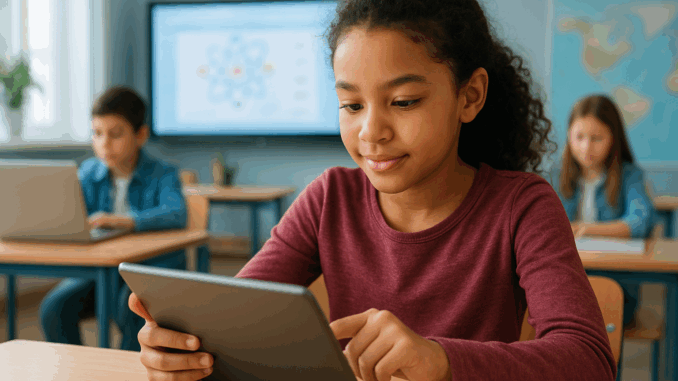
Future-Ready Classrooms: How Technology Is Transforming Modern Education
Education has always been a powerful force that shapes societies, drives innovation, and empowers individuals to reach their full potential. But in recent years, the world of learning has changed more dramatically than ever before. Technology, once used only as a supporting tool, has now become a central pillar of modern education. The rise of digital learning platforms, smart devices, artificial intelligence, and immersive technologies is transforming classrooms into dynamic, future-ready environments where students can learn more effectively, creatively, and collaboratively.
As we move deeper into the digital age, the concept of a “future-ready classroom” is no longer futuristic—it is a reality that is reshaping how students learn, how teachers teach, and how education systems operate. This article explores how technology is leading this transformation, the benefits it brings, and what the future holds for the next generation of learners.
The Evolution of the Classroom: From Chalkboards to Smart Boards
For decades, classrooms looked almost identical—rows of desks, chalkboards, textbooks, and teachers giving lessons at the front of the room. While this traditional model worked for its time, it limited creativity, personalized learning, and student engagement.
Today, technology has redefined the learning space.
Smartboards have replaced chalkboards, allowing teachers to present interactive lessons. Tablets and laptops have taken the place of heavy textbooks. High-speed internet has opened doors to global information. Classrooms are now designed for collaboration, curiosity, and active participation.
This shift marks the beginning of a new era—one where learning is not confined by physical walls or outdated tools.
Digital Learning Platforms: Expanding Access to Education
One of the most significant transformations in modern education is the rise of digital learning platforms. These platforms allow students to access lessons, assignments, videos, quizzes, and educational resources any time and from anywhere.
Key benefits include:
- Flexible learning: Students can learn at their own pace and revisit lessons they don’t understand.
- Global access: Remote learners, rural students, and those with disabilities can receive quality education without barriers.
- Efficient communication: Teachers can easily share materials, track progress, and provide personalized feedback.
Platforms like Google Classroom, Moodle, and Microsoft Teams have become essential tools in the digital classroom, supporting both in-person and online learning environments.
Artificial Intelligence: Personalizing the Learning Experience
Artificial Intelligence (AI) is playing a major role in creating future-ready classrooms. AI-powered tools can analyze student performance, identify learning gaps, and recommend personalized learning paths.
How AI transforms learning:
- Personalized lessons: AI can tailor educational content based on each student’s strengths and weaknesses.
- Assessment automation: Tools can grade assignments instantly, giving students faster feedback.
- Virtual tutors: AI-powered chatbots and tutoring apps assist students outside classroom hours.
- Predictive analytics: Educators can identify students who may need extra support before they fall behind.
Instead of a one-size-fits-all model, AI enables a learning environment that adapts to every student’s individual needs.
Interactive Tools: Making Learning More Engaging
Future-ready classrooms thrive on engagement, and technology introduces a new world of interactive tools that make learning truly exciting.
Examples include:
- Educational apps with games, quizzes, and simulations
- Touch-screen devices that allow hands-on learning
- Digital labs for science experiments using virtual tools
- Interactive projectors that allow group collaboration
Gamification—adding game-like features to learning—has also made lessons more enjoyable. Students are more motivated when they earn badges, complete levels, or participate in digital challenges.
These tools create a learning atmosphere where curiosity drives participation and engagement becomes natural.
Virtual Reality and Augmented Reality: Bringing Learning to Life
Few technologies are as transformative as Virtual Reality (VR) and Augmented Reality (AR). These immersive tools allow students to experience learning instead of simply reading about it.
VR in Education:
- Students can take virtual field trips to historical sites, outer space, or inside the human body.
- Simulations help students practice real-world scenarios safely.
AR in Education:
- Digital overlays bring textbooks and worksheets to life.
- Students can interact with 3D models of machines, ecosystems, or geometric shapes.
These technologies create powerful learning experiences that deepen understanding and spark imagination. For subjects like science, geography, medicine, or engineering, VR and AR make learning far more meaningful and memorable.
Cloud Computing: A New Approach to Data and Collaboration
Cloud technology plays a crucial role in keeping classrooms connected and efficient. Schools can now store large amounts of educational content, student data, and digital resources securely online.
Advantages of cloud-based education:
- Students can access assignments and materials from any device.
- Collaboration becomes easier through shared documents and group workspaces.
- Teachers can create digital portfolios that track student growth over time.
With cloud computing, learning is no longer limited to a physical classroom—students can continue their education anytime and anywhere.
STEM and Coding Education: Preparing Students for the Future
As economies become more technology-driven, skills in Science, Technology, Engineering, and Mathematics (STEM) have become essential. Future-ready classrooms integrate coding, robotics, and engineering projects to prepare students for the careers of tomorrow.
Why STEM education matters:
- Encourages problem-solving and creativity
- Builds logical thinking and analytical skills
- Prepares students for tech-related jobs
- Promotes innovation and teamwork
Coding classes, robotics competitions, and maker spaces are becoming common in schools worldwide. These hands-on activities allow students to build, test, and improve their creations in a fun, interactive environment.
Digital Literacy: A Core Skill for the Modern Student
As technology becomes part of everyday life, digital literacy has emerged as a critical skill for future generations. Students must know how to navigate the online world safely, responsibly, and effectively.
Future-ready classrooms teach students how to:
- Evaluate online information
- Communicate safely on digital platforms
- Protect their privacy
- Use digital tools for research, collaboration, and creativity
By ensuring students develop strong digital literacy skills, schools prepare them not only for academic success but also for life in a digital society.
Challenges of Technology in Education
While technology brings many benefits, it also introduces challenges that educators must address.
Some common issues include:
- Digital divide: Not all students have access to devices or internet at home.
- Screen fatigue: Too much screen time can affect health and attention.
- Cybersecurity risks: Schools must protect student data and privacy.
- Teacher training: Educators need ongoing training to use new technologies effectively.
To create truly future-ready classrooms, schools must balance innovation with inclusivity, safety, and proper support for both teachers and students.
The Future of Education: What’s Next?
The transformation of modern education is only just beginning. Over the next decade, classrooms will continue to evolve alongside technological innovation.
Future trends may include:
- AI-driven personalized learning paths
- Fully immersive VR classrooms
- Holographic teachers or virtual assistants
- Global classrooms where students learn with peers from other countries
- Data-driven learning analytics for real-time feedback
As technology becomes more advanced, education will become more flexible, more engaging, and more personalized than ever before.
Conclusion
Future-ready classrooms represent a powerful shift in how we think about education. Technology is no longer just an add-on—it is an essential part of the learning experience. From AI and VR to digital platforms and cloud tools, modern innovations are creating classrooms that are dynamic, inclusive, and deeply engaging.
As we move forward, the goal is not simply to use more technology, but to use it wisely and meaningfully. When teachers, students, and technology work together, education becomes a transformative journey that prepares learners for a fast-changing world.
The future of learning is here—and it is brighter, smarter, and more connected than ever.

